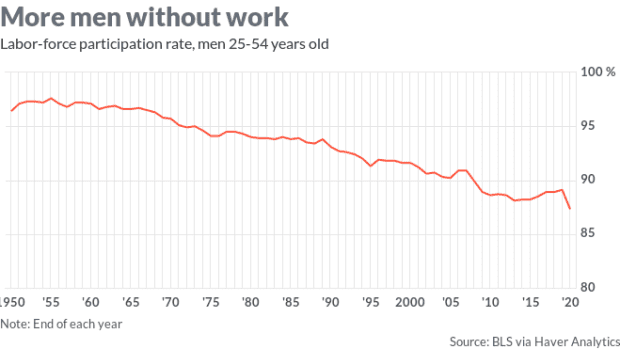This post was originally published on this site
Most observers interpret the Federal Reserve’s new monetary framework through the lens of the central bank’s price stability mandate, noting that the policy takes a broader view of acceptable inflation that will keep interest rates “lower for longer.” While true, this misses the most profound aspect of this new policy—Chairman Jerome Powell’s restatement of the bank’s full-employment mandate as a goal of a “broad-based and inclusive” labor market.
This laudable objective can only be met if the business community creates better pathways for hiring people with criminal records.
Rex Nutting: A hidden drag on the U.S. economy: men who can’t find work after prison

This commentary is based on a new book by Jeffrey Korzenik.
Bring back marginalized workers
The Fed’s labor-market intentions are rooted in sound economics. The long-term growth potential of any economy is a function of workforce growth and productivity gains. Our central bankers clearly want to use monetary policy to foster tight labor markets. Such markets and their higher wages can increase growth potential by bringing marginalized workers into the labor force.

Mass incarceration is one reason that the percentage of men between 25 and 54 who are in the labor force has dropped dramatically over the past 70 years.
To succeed, that academic theory must be coupled with a recognition of who has been sidelined from the U.S. workforce and what barriers they face to re-entry.
Americans burdened with a felony conviction, estimated at 19 million in 2010 and likely greater today, are among the largest groups marginalized from the workforce. While not all within this population are unemployed or otherwise absent from the workforce, the vast majority are not able to participate fully. The estimated 27% unemployment for this group actually understates the magnitude of the lost economic potential, since many with records lack the mobility to gain jobs that use their full potential and others have dropped out of the labor market completely.
Powell has specifically referenced racial disparities in the labor markets, and in this area a criminal conviction plays a particularly insidious role. The ugly aftermath of decades of elevated arrest and incarceration rates is that one in three Black men in America carries a felony conviction, to cite but one example. Beyond the formidable barriers of a record itself, the concentration of such employment hurdles within specific communities creates additional problems for succeeding generations. The pervasiveness of underemployment and joblessness has created a vicious cycle, disrupting structures of mentorship and the role models of work that many of us take for granted.
“
Second chance hiring is the path not only to greater prosperity, but to reduced racial disparities, safer communities and breaking the bonds of intergenerational poverty.
”
Despite the best intentions of diversity hiring goals, if employers continue to exclude applicants impacted by the justice system, our workforce will never reflect our population.
It’s business, not charity
“Second chance” or “fair chance” hiring, the employment of people with records, is a business proposition, not charity. Those companies that have invested in this talent pipeline have found that such hires are highly engaged and loyal, a recipe for productivity and the cost savings associated with low employee turnover.
Successful companies build processes that identify which applicants are ready for employment and provide the support so that these workers can succeed; this is an investment, but one with a high return. Without this specific approach, many employers have only had negative experiences with hiring from this pool.
Even without a patient central bank, employers may soon learn that decades of declining birthrates in the U.S., the continued retirement of the baby boomers, and the skill and geography mismatches created by the disruptions of the pandemic will create a shortage of workers much sooner than expected. The Fed’s new monetary framework ensures that tight labor markets will persist for years, requiring corporate leaders who can attract, retain and develop talent wherever it is found. The population of people with criminal records is simply too large to be ignored.
If the Fed’s new monetary policy fails to bring workers back to the labor market, it risks inflation—tight labor markets that disrupt business growth as wage gains outstrip productivity growth. If the business community can recognize the Fed’s new framework as an opportunity to make the long-term investment needed for marginalized workers to flourish, we will all win.
Second chance hiring is the path not only to greater prosperity, but to reduced racial disparities, safer communities and breaking the bonds of intergenerational poverty.
Jeff Korzenik is chief investment strategist of Fifth Third Bank and the author of “Untapped Talent: How Second Chance Hiring Works for Your Business and the Community” (HarperCollins Leadership, April 2021). The views expressed herein are his own and do not necessarily reflect the views of Fifth Third Bank.
More economic coverage:
Biden may have to relent on the SALT cap to get his tax plan through Congress
Americans grow increasingly confident in the economy and expect unemployment to decline
Government policies segregated America, and we could harness that same force to reverse the damage

